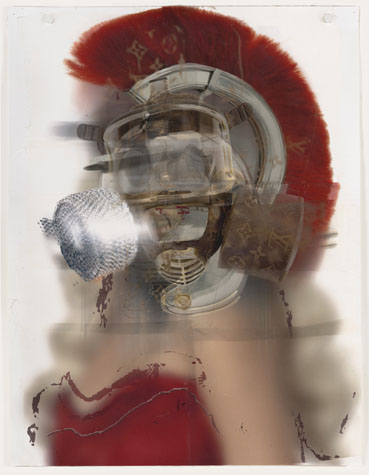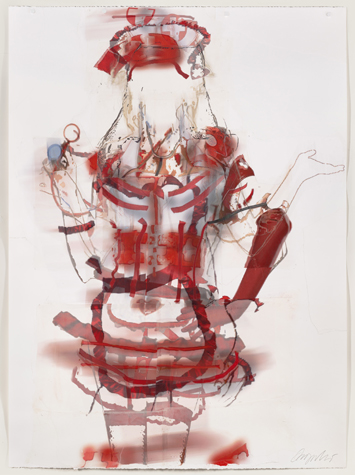 |
Few artists have blurred the line between photography and painting as thoroughly and convincingly as Deborah Oropallo. Her pixel-by-pixel method of reworking Internet images is, by its very nature, perfectly suited to an era in which personal identity can be reinvented on-the-fly with a few mouse clicks. But unlike the ideologically freighted identity art of the ‘80s and ‘90s, Oropallo’s is refreshingly open-ended. It doesn’t proselytize; it just poses and fantasizes. Its high-camp, wide-open, anything-goes stance, will, I predict, position Oropallo as the art world’s answer to the virtual one we’ve created. That Internet downloads enabled her futuristic, gender-confused universe makes the irony of its creation as delicious as the artist’s irrepressible bad-girl attitude. That her art breaks through our acquired resistance to media imagery is, I think, a tribute to the 20 years the artist spent as a painter before moving into the digital realm in 2000.
Guise, her 2007 show at the de Young Museum, was a major breakthrough. Onto 17th century portraits of aristocrats, emperors, kings and other authority figures, Oropallo superimposed female faces. She replaced pants with skirts, stockings with garters and boots with high-heels. The result was an androgynous look in which power poses and gestures typically struck by men were inhabited by she-men. Wrapped in a kind of gauzy, anamorphic, now-you-see-it-now-you don’t haze, the pictures baffled unassuming visitors, fooling them into thinking they were viewing tired old museum fare, when in fact the notion of the inviolable historic portrait was being surreptitiously and slyly subverted. The pictures were convincingly male and female; they conveyed what a third gender might actually look like. They revised the history of power relations between the sexes, creating as Oropallo has stated, “a new royalty” out of nurses, maids and others low on history’s social totem pole.
 |
Two years later, at the Stephen Wirtz Gallery (and at Gallery 16 which created prints from the series), she unveiled the Wild, Wild West Show: kitschy fantasy pictures based on downloaded images of rodeo queens clad in skimpy outfits. Like the figures in Guise, these felt like apparitions, too. The source images, which underwent extreme digital surgery, appeared to have been selectively erased, and with only portions of the bodies and pieces of clothing intact, all that remained were ghosts executing hyperkinectic gestures. Measuring nearly seven feet tall and mounted on aluminum panels, the prints were at once intimate and distant, erotic and horrifying. They were also radical and thrilling. Oropallo had pushed her skills as a digital painter to a new level – one that probably didn’t win over any old-school critics who wished she’d return to the brush. But she definitely re-affirmed and enlarged her status as a game-changing artist.
Tale Spin, Oropallo’s current exhibit at Gallery 16, builds on those innovations. For openers each print is unique. The source images, culled from costume websites, are printed on paper-backed lengths of silk and chiffon and affixed to sheets of paper. The resulting pictures are messy, highly tactile composites of bold, see-through action gestures. Their distressed surfaces, with their dangling threads, have a battered, bandaged look – one whose multiple layers will likely require an almost anthropological effort on the part of viewers to fully soak in the details. Where Cindy Sherman is the historical antecedent for Guise, de Kooning, with his slashing gestures and fierce, comic, demonic women provide the template for Tale Spin. Oropallo’s, like de Kooning’s, are composed of parts that seem to live independent lives and create crazy shifts in pictorial anatomy. But they are clearly her own. They reflect the artist’s complex relationship to the stuff of her childhood: uniforms, costumes and fairytales. The latter, she recently told a Gallery 16 audience, are always “about death and dismemberment and rape; a little girl is always the victim. I wanted these girls to be grown up in kind of a post-feminist way,” one “that would put the wolf on the run.”
 |
To effect such a “spin” the artist asked, “What would Bo Peep be afraid of today?” From web queries like “designer gas mask” she found answers in products like the Emergency Bra, whose cups convert into a dual respirator gas mask, perfect for protection against terrorist attacks like 9/11 which spewed toxic dust across Manhattan. “That would be what you would have to be afraid of if you were a shepherd today,” Oropallo stated.
The figures in Tale Spin mix terror and humor in roughly equal parts. Gas-mask outfitted models are funny. Faceless mini-skirted babes, not so much. In between those poles, Oropallo offers a host of female superheroes striking poses we’ve seen in comic characters from Wonder Woman and Spider Man to Bat Man and Captain America. Like Guise, which postulated a world of infinitely fluid sexuality, Tale Spin operates outside the axis of good vs. evil. The figures project power, but their titles (Entangled, Dubious, Cured, Cursed, Powerlessness, Lost, Hushed, and Muffled ) take it away. Make what you will of that.